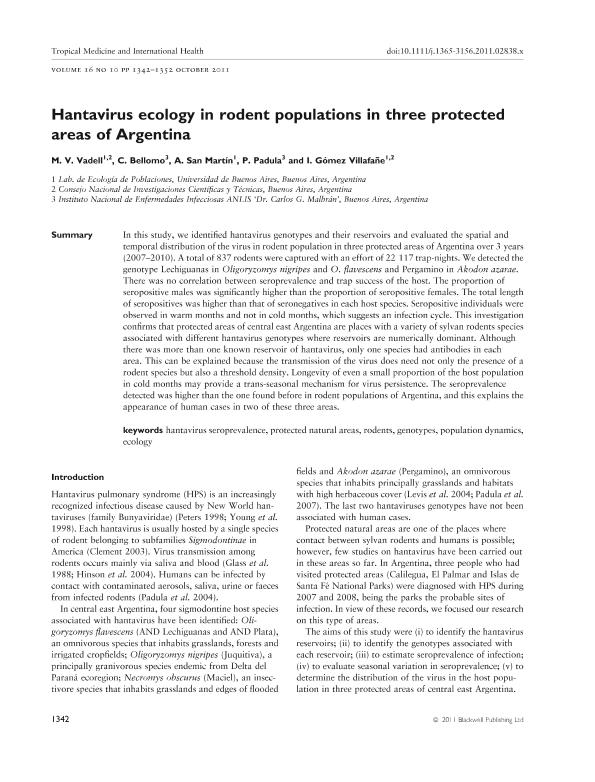Mostrar el registro sencillo del ítem
dc.contributor.author
Vadell, María Victoria

dc.contributor.author
Bellomo, Carla
dc.contributor.author
San Martín, Alvaro

dc.contributor.author
Padula, Paula Julieta

dc.contributor.author
Gomez Villafañe, Isabel Elisa

dc.date.available
2019-01-25T20:33:53Z
dc.date.issued
2011-10
dc.identifier.citation
Vadell, María Victoria; Bellomo, Carla; San Martín, Alvaro; Padula, Paula Julieta; Gomez Villafañe, Isabel Elisa; Hantavirus ecology in rodent populations of three protected areas of Argentina; Wiley Blackwell Publishing, Inc; Tropical Medicine And International Health; 16; 10; 10-2011; 1342-1352
dc.identifier.issn
1360-2276
dc.identifier.uri
http://hdl.handle.net/11336/68671
dc.description.abstract
In this study, we identified hantavirus genotypes and their reservoirs and evaluated the spatial and temporal distribution of the virus in rodent population in three protected areas of Argentina over 3years (2007-2010). A total of 837 rodents were captured with an effort of 22117 trap-nights. We detected the genotype Lechiguanas in Oligoryzomys nigripes and O. flavescens and Pergamino in Akodon azarae. There was no correlation between seroprevalence and trap success of the host. The proportion of seropositive males was significantly higher than the proportion of seropositive females. The total length of seropositives was higher than that of seronegatives in each host species. Seropositive individuals were observed in warm months and not in cold months, which suggests an infection cycle. This investigation confirms that protected areas of central east Argentina are places with a variety of sylvan rodents species associated with different hantavirus genotypes where reservoirs are numerically dominant. Although there was more than one known reservoir of hantavirus, only one species had antibodies in each area. This can be explained because the transmission of the virus does need not only the presence of a rodent species but also a threshold density. Longevity of even a small proportion of the host population in cold months may provide a trans-seasonal mechanism for virus persistence. The seroprevalence detected was higher than the one found before in rodent populations of Argentina, and this explains the appearance of human cases in two of these three areas.
dc.format
application/pdf
dc.language.iso
eng
dc.publisher
Wiley Blackwell Publishing, Inc

dc.rights
info:eu-repo/semantics/openAccess
dc.rights.uri
https://creativecommons.org/licenses/by-nc-sa/2.5/ar/
dc.subject
Ecology
dc.subject
Genotypes
dc.subject
Hantavirus Seroprevalence
dc.subject
Population Dynamics
dc.subject
Protected Natural Areas
dc.subject
Rodents
dc.subject.classification
Otras Ciencias Biológicas

dc.subject.classification
Ciencias Biológicas

dc.subject.classification
CIENCIAS NATURALES Y EXACTAS

dc.title
Hantavirus ecology in rodent populations of three protected areas of Argentina
dc.title
Ecologie de l’hantavirus dans les populations de rongeurs dans trois zones protégées de l’Argentine
dc.type
info:eu-repo/semantics/article
dc.type
info:ar-repo/semantics/artículo
dc.type
info:eu-repo/semantics/publishedVersion
dc.date.updated
2019-01-25T13:43:46Z
dc.journal.volume
16
dc.journal.number
10
dc.journal.pagination
1342-1352
dc.journal.pais
Reino Unido

dc.journal.ciudad
Londres
dc.description.fil
Fil: Vadell, María Victoria. Universidad de Buenos Aires. Facultad de Ciencias Exactas y Naturales. Departamento de Ecología, Genética y Evolución. Laboratorio de Ecología de Poblaciones; Argentina. Consejo Nacional de Investigaciones Científicas y Técnicas; Argentina
dc.description.fil
Fil: Bellomo, Carla. Dirección Nacional de Instituto de Investigación. Administración Nacional de Laboratorio e Instituto de Salud “Dr. C. G. Malbrán”; Argentina
dc.description.fil
Fil: San Martín, Alvaro. Universidad de Buenos Aires. Facultad de Ciencias Exactas y Naturales. Departamento de Ecología, Genética y Evolución. Laboratorio de Ecología de Poblaciones; Argentina. Consejo Nacional de Investigaciones Científicas y Técnicas; Argentina
dc.description.fil
Fil: Padula, Paula Julieta. Dirección Nacional de Instituto de Investigación. Administración Nacional de Laboratorio e Instituto de Salud “Dr. C. G. Malbrán”; Argentina. Consejo Nacional de Investigaciones Científicas y Técnicas; Argentina
dc.description.fil
Fil: Gomez Villafañe, Isabel Elisa. Universidad de Buenos Aires. Facultad de Ciencias Exactas y Naturales. Departamento de Ecología, Genética y Evolución. Laboratorio de Ecología de Poblaciones; Argentina. Consejo Nacional de Investigaciones Científicas y Técnicas. Oficina de Coordinación Administrativa Ciudad Universitaria. Instituto de Ecología, Genética y Evolución de Buenos Aires. Universidad de Buenos Aires. Facultad de Ciencias Exactas y Naturales. Instituto de Ecología, Genética y Evolución de Buenos Aires; Argentina
dc.journal.title
Tropical Medicine And International Health

dc.relation.alternativeid
info:eu-repo/semantics/altIdentifier/url/http://onlinelibrary.wiley.com/doi/10.1111/j.1365-3156.2011.02838.x/full
dc.relation.alternativeid
info:eu-repo/semantics/altIdentifier/doi/https://doi.org/10.1111/j.1365-3156.2011.02838.x
Archivos asociados
